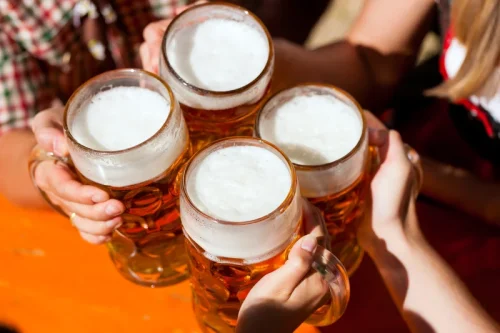
It is important that as you try to help your loved one, you also find a way to take care of yourself. It may help to seek support from others, including alcoholism friends, family, community, and support groups. If you are developing your own symptoms of depression or anxiety, think about seeking professional help for yourself. Remember that your loved one is ultimately responsible for managing their own illness. It is rare that someone would go to treatment once and then never drink again.
Medication for Alcoholism, Withdrawal & Cravings
Previously the effects of nalmefene and other opioid agonist were evaluated in male Wistar rats that self-administer ethanol in standard operant conditioning method or exposed to 4-week intermittent ethanol vapor exposure for 14 hours per day for 4 weeks. After confirming the alcohol dependence, nalmefene (0 – 0.1mg/kg, s.c) and naltrexone (0 – 1mg/kg, s.c) were administered to Wistar rats. The role of the endocannabinoid system in the AUD has been evaluated by many laboratories. By using animal and cell culture models, it has been demonstrated that chronic ethanol exposure causes an increase in endocannabinoid levels and downregulate cannabinoid receptor-1 (CB1) (Basavarajappa & Hungund, 2001). Similarly, down-regulation of CB1 receptors has been reported in multiple regions of the human alcoholic brains as evaluated by positron emission tomography (PET) (Normandin et al., 2015).
Starting with a Primary Care Provider
The alcohol-aversive effects of Antabuse were first recorded in the 1930s. Workers in the vulcanized rubber industry who were exposed to tetraethylthiuram disulfide became ill after drinking alcohol. Each of these fee-based tools has a research base that shows its potential to help people cut down or quit drinking. Some people are surprised to learn that there are medications on the market approved to treat AUD. The newer types of these medications work https://ecosoberhouse.com/ by offsetting changes in the brain caused by AUD.
d. Other Medications

In the alcohol reinstatement model, pregabalin (0, 10 and 30 mg/kg) abolished alcohol seeking behavior elicited by the pharmacological stressor yohimbine, suggesting its role in the treatment of alcohol addiction. The effects of pregabalin were evaluated on nitroglycerin (NTG)-induced hyperalgesia in male Sprague-Dawley rats. Pretreatment of rats with pregabalin (10 – 30mg/kg, s.c) thirty minutes prior to NTG (10mg/kg, i.p) injection alleviated NTG-induced hyperalgesia and suppressed peripheral calcitonin-gene-related peptide (CGRP) (Di et al., 2015). Previously, the anticonvulsant effects of pregabalin were evaluated in mice. Adult mice were chronically exposed to ethanol and upon withdrawal examined for the behavioral signs of seizure activity such as handling-induced convulsions (HIC) or abnormalities in EEG activity recorded from cortical and subcortical regions.
- People assigned female at birth (AFAB) should limit drinking to one drink a day.
- Circulating metabolites of duloxetine do not contribute significantly to the pharmacologic activity (Stahl & Grady, 2005; Bymaster & Lee, 2005).
- The National Institute on Alcohol Abuse and Alcoholism (NIAAA) is supporting research to identify genetic, behavioral, and other factors that can predict how well someone will respond to a particular treatment.
- It has moderate affinities for histamine and α-adrenergic receptors and serotonin transporters.
- To further study the pharmacokinetic or pharmacodynamic interaction in between ABT-436 and alcohol, Katz et al., (2016) conducted a single-dose clinical study in twenty moderate alcohol drinkers.
- Overall, gather as much information as you can about a program or provider before making a decision on treatment.
- In an another clinical trial, baclofen has been investigated to reduce craving, voluntary alcohol intake and withdrawal syndrome of alcoholic patients.
- Since glycine is known to elevate extracellular dopamine levels in the NAc and decrease alcohol consumption, a highly selective glycine reuptake inhibitor could be used to decrease alcohol consumption.
- Initially, disulfiram was given in larger dosages to produce aversion conditioning to alcohol by making the patients very sick if they drank.
- These three alcohol medications come in pill form, and naltrexone also comes in injectable form.
415 KB).
Just as some people with diabetes or asthma may have flare-ups of their disease, a return to drinking can be seen as a temporary setback to full recovery and not as a failure. Seeking professional help can prevent a return to drinking—behavioral therapies can help people develop skills to avoid and overcome triggers, such as stress, that might lead to drinking. Medications can also deter drinking during times when individuals may be at greater risk for a return to drinking (e.g., divorce, death of a family member).

Alcohol abusers are “problem drinkers”, that is, they may have legal problems, such as drinking and driving, or binge drinking (drinking six or more drinks on one occasion). Recent studies have shown that OT influences a number of behavioral and physiological effects of alcohol, including tolerance, withdrawal, and motivational effects (Lee & Weerts, 2016). Systemic administration of OT reduces alcohol preference and intake in a variety of drinking models in rats (MacFadyen et al., 2016) and mice (King et al., 2017). Bowen et al has demonstrated that OT specifically attenuates ethanol-induced motor impairment via GABAergic activity at δ-GABAA receptor (α4β1δ and α4β3δ) subunits without activating OTR.




